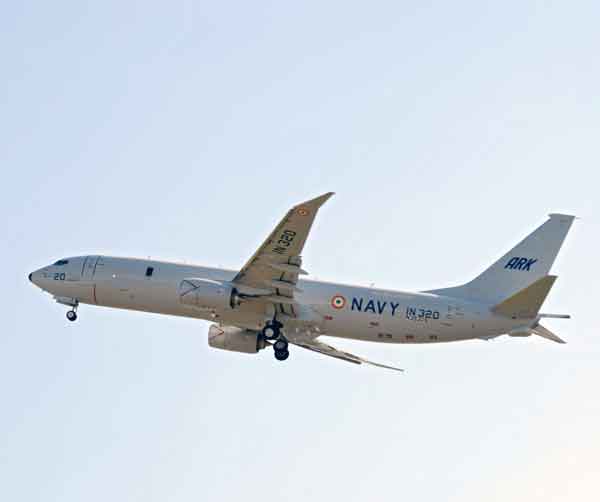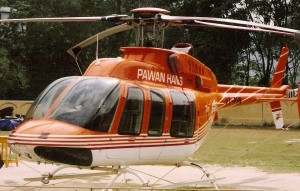The helicopter is the workhorse for the off-shore oil and gas exploration and production industry. The ever-increasing demand for energy, ever escalating prices of crude oil and the discovered existence of oil and gas in off-shore areas ensure that there is a hectic increase in off-shore oil exploration in recent times. More and more hitherto untouched off-shore areas are being explored and developed through large public and private sector investments. Helicopters form an essential and critical part of off-shore operations as they connect these facilities to the mainland.
The most important off-shore oilfield is at Mumbai High, located in the Arabian Sea around 160 km West off the Mumbai coast…
The World Energy Outlook 2012, published by International Energy Agency at the end of last year, prophesizes that global energy demand is likely to grow by more than a third of its present level by 2035 and that, China, India and the Middle East would account for 60 per cent of that increase. Although known energy reserves are in no danger of immediate exhaustion or extinction, the competition for their use is natural and fierce due to their predictably finite quantum.
A World Energy Assessment Report (UNDP 1999) has defined energy security as, “the continuous availability of energy in varied forms in sufficient quantities at reasonable prices”. The challenge lies not just in the “sufficient quantities” signifying the need for newer and ever more extensive sources of energy to meet growing energy needs, but also to make the energy available at “reasonable prices”. This scenario, wherein many users are contending for limited and indeed depleting energy sources, justifies the nomenclature of energy security.
India accounts for 4.6 per cent of the world’s annual energy consumption and is the world’s fourth largest consumer of primary energy, with only China, USA and Russia consuming more than it. Moreover, in the last five years, India has grown at an average rate of eight per cent and the demand for energy has risen commensurately. Crude oil imports have been gradually rising in India and account for three fourths of the nation’s total requirements now.
Similarly, natural gas imports account for more than a fifth of the nation’s requirements. Even more alarmingly, by the end of the Twelfth Plan (2012-2017), import dependence on crude oil is expected to increase to around 80 per cent and import dependence on natural gas is expected to increase to 35 per cent. High import dependence is analogous to high vulnerability and lowered energy security of the nation. This is so, not just because high import dependence leads to the GDP growth rate becoming dependent on external factors namely oil prices, but also because it holds the potential for increased fiscal deficit and depleting foreign exchange reserves.
Pawan Hans Helicopters Limited (PHHL) is the largest helicopter operator engaged in off-shore operations…
A seminal policy document called the Integrated Energy Policy produced by an expert committee of the Planning Commission felt it necessary to redefine energy security in the specific Indian context in the following words, “We are energy secure when we can supply lifeline energy to all our citizens irrespective of their ability to pay for it as well as meet their effective demand for safe and convenient energy to satisfy their various needs at competitive prices, at all times and with a prescribed confidence level considering shocks and disruptions that can be reasonably expected.” It is to eliminate or at least minimise ‘the shocks and disruptions’ so that uninterrupted supply of oil and gas from our off-shore exploration and production facilities becomes an energy security imperative.
Indian Off-Shore Oil Facilities
Although oil exploration began in India in 1867, when oil was struck at Makum in Assam, exploration and production was formalised only in 1899, after the Assam Oil Company was formed. At the time of Independence, India’s annual domestic oil production was just 250,000 tonnes. Added impetus was provided by the Industrial Policy Resolution of 1954, wherein the Government announced that petroleum would be considered as a core sector in the country. The Geological Survey of India executed extensive surveys to locate structures suitable for exploration of oil and gas.
The setting up of Oil and Natural Gas Commission (ONGC), in 1955 was a momentous point in petroleum exploration in India. The discovery of the vast off shore Bombay High field in 1974, off the West coast was perhaps the most significant event in India’s petroleum sector. The Government further liberalised the petroleum exploitation and exploration policy in 1991, and invited private companies, both foreign and Indian, to participate in the exploration of oil and gas. Since then many more players have entered the exploration and production fray, both in on-shore and off-shore areas.
According to the Ministry of Petroleum and Natural Gas, India has an estimated sedimentary area of 3.14 million sq. km. comprising 26 sedimentary basins out of which 1.35 million sq. km. area is in deep water and 1.79 million sq. km. area includes land or shallow off-shore basins. At present, 1.06 million sq. km. is under active petroleum Exploration Licenses in 18 basins by national oil companies and private/joint venture companies. A total of 35,601 sq. km. is under mining lease.
Helicopters render constructive and irreplaceable service to sustain off-shore operations…
Operations are being carried out by national and private oil companies in 597 concessions, of which 259 are under Petroleum Exploration License (PEL) and 338 are under Mining Lease (ML). Off-shore basins lie in its Exclusive Economic Zone West and East of India as also in the Andaman and Nicobar area. The most important off-shore oilfield is at Bombay High (now Mumbai High). It is located in the Arabian Sea around 160 km West off the Mumbai coast. Discovered in 1974, the field has been operated by Oil and Natural Gas Corporation (ONGC). Production at the field started in 1976. The oil field consists of two blocks named Mumbai High North (MHN) and Mumbai High South (MHS) and currently has 1,659 million metric tons (MMT) capacity and is producing around 12MMT a year. In a long term programme, Phase II development is going on to enhance the production capacity of the oilfield complex.
Significant exploration and production is also on in the Krishna-Godavari (KG) basin. It is reasonable to presume that off shore operations will increase in extent and value with more discoveries away from land. These operations are predicated to high value offshore assets requiring enormous investment.
Off-Shore Helicopter Operations
All these off-shore assets are strategic in nature and the loss of any such asset can have distressing consequences as in the case of the fire incident in Bombay High North platform in 2005 which affected a quarter of the nation’s total production output until repairs and replacements could be put into place. At the time of the fire, there were 384 personnel onboard, of which 362 were rescued. Off-shore facilities are located away from land and have Spartan living spaces for the personnel working there.
As the personnel have to stay away from families and under difficult conditions with a small but nonetheless extant risk to life and limb, they need to be kept on station for short periods and rostered on rotation bases. Typically, a person may stay and work on a facility for about two weeks. A person from a land base would be flown by helicopter to a living-in base. On a daily basis, personnel are moved from living-in bases to bases which are normally unmanned to which they would go in the morning and return at the end of a working day. There is also a need to support these facilities logistically on a daily basis. Helicopters render constructive and irreplaceable service to sustain off-shore operations, firstly on a routine basis, and secondly, to deal with casualty evacuation in case of a medical emergency or accident at the facility.
Off-shore helicopter flying is a strenuous task and often conducted in abnormal operating conditions for both flight crew and their aircraft. Flights are in poor visibility conditions, very frequently with no horizon reference, and require high levels of skill, especially for the take-off and landing phases from small table-top heli-decks above the surface of the sea. The airframes and engines have to endure highly corrosive, salt-laden environment.
Flying to offshore platforms and floating decks has its own peculiarities…
Flying to offshore platforms and floating decks has its own peculiarities. The small size of the heli-decks surrounded by obstacles, hot gases, capricious wind velocities and rapidly changing meteorological conditions can be challenging for pilots. In addition, the pitching, rolling and heaving experienced while landing on floating decks require a very high degree of skill and accuracy in flying. According to Captain Sanjay Mittal, Training Manager, Global Vectra Helicopters Limited (GVHL), “An off-shore helicopter mission off the coast of peninsular India can be the simplest task on a bright sunny winter day but the very same flight undertaken on a dark moonless night to a destination over 160 km into the sea for medical evacuation or a routine day crew change flight during the peak of South West monsoon can be extremely challenging even for the very best of professional helicopter pilots.”
The office of the Director General Civil Aviation (DGCA) considers off-shore helicopter flying a specialised operation and mandates that pilots engaged in this role be given specific role oriented training. Needless to say, execution of safe and efficient operations requires highly professional flight and maintenance crew as also good operational managers so that air safety is not compromised.
Pawan Hans Helicopters Limited (PHHL) is the largest helicopter operator engaged in off-shore operations. For its Mumbai operations, the land base is Juhu airport from where around ten helicopters carry out two to three flights each in support of off-shore facilities. These flights are normally sunrise-to-sunset affairs while at night one helicopter stays on one of the facilities for emergencies and night ambulance duties. PHHL also carries out flying on the East coast. The next largest off-shore operator is GVHL which flies off Mumbai in the West as well as off Rajahmundry in the East and has seven Bell 412s and two AW 139s on long-term contracts to ONGC and British Gas.
The remote location of off-shore facilities, far away from land and inhabitation renders them very vulnerable…
Other operators include Heligo, UHPL, Deccan Charters and Reliance, which is the only Oil and Gas company to own helicopters (two Bell 412s) which are tendered out on an Operations and Maintenance contract, typically for two years at a time, to a helicopter operating company. Presently, the contract is with GVHL for the operations and maintenance of these two helicopters. Cairn and Transocean, two other off-shore companies, do not have their own helicopters and have contracted helicopter operating companies such as PHHL, GVHL, Heligo, United Helicharters Private Limited UHPL and Deccan Charters to meet their requirements.
In addition to the oil and gas production that is underway on the West and East coast, as already described, exploration and production companies that have been awarded contracts under the NELP policy of the Ministry of Petroleum undertake regular seismic survey operations in respective off-shore blocks. These operations are conducted in non-monsoon months that is from October to May and employ helicopters for air logistic support. During the year 2012-2013, such operations were conducted off the North West coast of Andaman and Nicobar Islands with two support helicopters based at Port Blair. On completion of survey work, exploratory wells are drilled in areas identified as having resources of oil and gas to further establish economic viability of progressing with commercial drilling operations. Presently, such exploratory wells are being drilled off the Orissa and Andhra coast supported by helicopters based at Bhubaneswar, Rajahmundry and Vishakhapatnam.
Currently, about 40 helicopters are employed in the off-shore sector both on the Western and Eastern coasts…
Vulnerability of Off Shore Operations
The remote location of off-shore facilities, far away from land and inhabitation renders them very vulnerable assets. A RAND Corporation study on the subject of “Potential Threats to Offshore Platforms” lays out an array of threats from guerrillas and terrorism, extortionists, sabotage and hostile take-over of facilities by internal labour activists, environmental extremists and thieves targeting equipment and material. However, as far as surreptitious assaults go, the very location of these facilities renders them difficult to approach except by the very determined and the very well resourced. The probability of risk to their safety and security is low, but the consequences of a consummated risk (resulting in a threat turning into an actual attack, would be extremely high.
Apart from these possible risks, there is always the menacing peril of hostile wartime action like the shelling of Iranian off-shore platforms by US warships in 1987 in retaliation to Iranian attacks on shipping in the Persian Gulf. In the Indian context, the threat from Pakistani action by the sea or submarine route is a possibility that can neither be undermined nor neglected or ruled out. A successful Pakistani attack on a facility, such as in the Mumbai High complex, would not only mean a blow to the oil and gas production but would also signify a body-blow to national pride.
The helicopter is the workhorse for the off-shore oil and gas exploration and production industry. The ever-increasing demand for energy, ever escalating prices of crude oil and the discovered existence of oil and gas in off-shore areas ensure that there is a hectic increase in off-shore oil exploration in recent times. More and more hitherto untouched off-shore areas are being explored and developed through large public and private sector investments. Helicopters form an essential and critical part of off-shore operations as they connect these facilities to the mainland.
As oil exploration moves further offshore, the demand for better and modern helicopters is bound to increase…
Currently, about 40 helicopters are employed in the off-shore sector both on the Western and Eastern coasts. Flying carried out by them represents more than three-fourth of the total civil helicopter flying in India. As oil exploration moves further offshore, the demand for modern helicopters with better range and advanced safety features is bound to witness a marked increase. The operational safety of the helicopters themselves is a vulnerability that comes from the very nature and harsh environment of their operations. Sporadic hull loss accidents in the offshore domain keep underscoring the need for special emphasis on operational, maintenance and procedural issues to reduce the risk of flying accidents to the helicopters involved.
Conclusion
As is the case with all areas of Indian strategy, energy security strategy is also unclear and its determinants rather tenuous and questionable. There does not seem to be any consistent strand running through policy iterations to indicate any particular choice of energy strategy. Superimposed on this weakness is the fact that oil and coal companies are state-owned and prices of all hydrocarbon and power sectors are regulated by the government with the exception of petrol which is partially deregulated since June 2010. As a result, private sector finds the energy sector largely devoid of allure. Had these policies been inspired by pragmatic energy security imperatives, they would have been laudable.
However, the state regulatory mechanism does not sub-serve energy security or national security demands. Instead it panders to vote bank politics. Ostensibly, the subsidies have the objective of protecting consumers from international price volatility and providing energy access for the common man, especially those who hover close to the poverty line. However, their true intent is to nurture vote banks. As a result of these energy subsidies, a heavy burden is placed on government budgets, while targeted beneficiaries often remain bereft of the intended benefit. Successive changes of government and ruling parties have not been able to cross the Rubicon of the energy sector price deregulation.
The safe and efficient operation of existing and future off-shore facilities remains predicated to off-shore helicopter operations…
Large scale liberalisation and consequent privatisation of the sector, therefore, appear to be distant dreams. The Hydrocarbon Vision 2025, a document produced by the Indian government in 2000, recommended intensification of exploration efforts and securing acreages in countries that appear highly attractive for ensuring sustainable long-term supplies such as Russia, Iran, Iraq and North Africa. The implication is that Indian off-shore assets could be outside the EEZ. The Integrated Energy Policy Report of 2006 added that obtaining equity oil, coal and gas abroad do not represent adequate strategies for enhancing energy security beyond diversifying supply resources. An intent to further explore the EEZ for more oil and gas discoveries can be read in this iteration.
While India’s Sixth Five Year Plan had stipulated self-sufficiency in the development of domestic oil resources and pricing reforms, subsequent Five Year Plans stressed the idea of self-sufficiency through ownership of resources outside India. The Twelfth Plan projects an alarming figure of import requirements as mentioned earlier. Whether seen against the backdrop of increasing energy demand or in the context of rising proportion of imported oil, the relevance of off-shore oil and gas exploration and production stands out as an important determinant of energy security. The safe and efficient operation of existing and future off-shore facilities remains predicated to off-shore helicopter operations.







